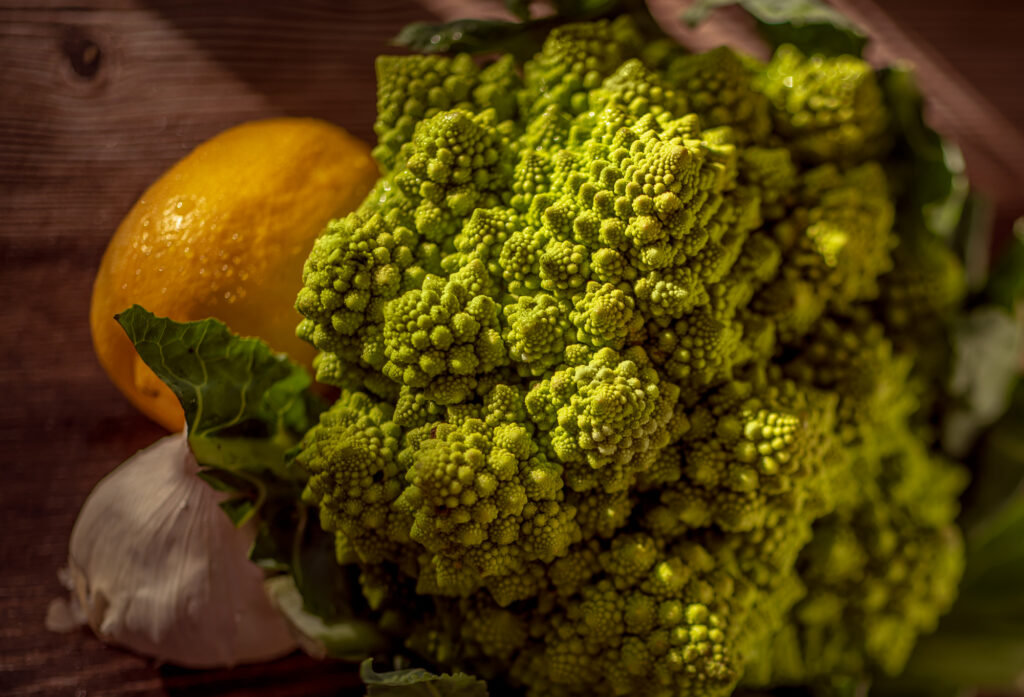Unveiling the Unique Beauty of Romanesco: Photographing the Fibonacci Sequence with Bruce Johnson Studios
Working as a food photographer, I’ve had the pleasure of capturing many beautiful dishes and ingredients prepared by some awesome chefs. However, there’s one vegetable that always catches my eye – Romanesco. This beautiful vegetable is not only delicious, but it’s also a perfect example of the mysterious Fibonacci sequence. In this article, I’ll share with you my tips on how to photograph Romanesco to highlight its mathematical wonder.
Romanesco is a beautiful vegetable that belongs to the cruciferous family. It has a unique appearance that looks like a fractal, with small cones that spiral outwards. Its bright green color makes it a beautiful ingredient to work with, and its flavor is a cross between cauliflower and broccoli. Romanesco originated in Africa and was first domestically cultivated in the Lazio region of Italy, and it’s commonly used in Italian cuisine.
The Fibonacci sequence is a series of numbers where each number is the sum of the two preceding ones. This sequence goes on indefinitely, and it’s found in many natural phenomena, such as the spiral patterns in seashells, flowers, and pinecones. The Fibonacci sequence is also found in the spirals of a Romanesco.
Romanesco’s spiral pattern is a perfect example of the Fibonacci sequence. When you count the spirals on Romanesco, you’ll find that they follow the Fibonacci sequence. The number of spirals in each direction is usually a Fibonacci number – 1, 1, 2, 3, 5, 8, 13, 21, and so on. This unique pattern makes Romanesco a beautiful subject to photograph.
To showcase the unique pattern of Romanesco, I backlit it through a series of Gobos of different textures and a simple warm fill light. I used a Nikkor 90mm tilt-shift lens and shifted the focal plane diagonally across the frame. Focus originates in the center of the frame and the depth of field carries from left-center to the right far edge following the contour of the subject instead of the traditional back-to-front alignment. This setup brings the fractal cones into sharp focus while creating a soft negative space in the upper left pulling the eye to the sharp surface of the Romanesco.
Romanesco has a long history in Italian cuisine. It originated in Italy in the 16th century and was first documented in the book “De Re Rustica” by Italian agronomist Pietro Andrea Mattioli. Romanesco is commonly used in Italian dishes, such as pasta and risotto. It’s also a popular ingredient in Mediterranean cuisine and is known for its health benefits. Romanesco, Broccoli and Cauliflower are Brassicas and are known cancer fighters.
Mathematics and food may seem like an unlikely pair, but there’s a lot of mathematical symbolism in food and photography. The Fibonacci sequence is just one example. Other mathematical principles, such as the golden ratio and fractals, can also be found in food photography and provide great compositional guides. Understanding these principles can help food photographers create stunning images that highlight the beauty of the ingredients they’re working with.
If you’re looking to incorporate Romanesco into your cooking, there are many delicious recipes to choose from. One popular recipe is Romanesco soup, which combines Romanesco with potatoes, onions, garlic, herbs and chicken broth. Another tasty option is Romanesco pasta, which features the vegetable in a creamy sauce with pancetta and Parmesan cheese. Often it is simply steamed or roasted and served with lemon. These recipes not only taste great but also showcase the unique beauty of Romanesco. Find more recipes here: https://www.allrecipes.com/gallery/romanesco-recipes/
If you’re in the Raleigh, Durham, or Chapel Hill area, you can find Romanesco at local farmers’ markets and specialty food stores. Some of the best places to look include the Durham Farmers’ Market, the Raleigh Farmers’ Market, and Weaver Street Market in Chapel Hill. You can also check with your local grocery stores, as some may carry Romanesco during the winter months. I found mine at Sprouts on Falls of the Neuse in North Raleigh. It was delicious!
Romanesco is a beautiful vegetable that not only tastes great but also showcases the beauty of mathematics. By understanding the Fibonacci sequence and how it relates to Romanesco, food photographers can create stunning images that highlight the unique pattern of the vegetable. Additionally, incorporating Romanesco into your cooking is a great way to appreciate the beauty of math in unexpected places. Whether you’re a food photographer or a home cook, Romanesco is a must-try ingredient that’s sure to impress.
If you need help with your next food photography project, don’t hesitate to contact us at Bruce Johnson Studios. We’d love to help you capture the unique beauty of your creations.
Comments are closed.


